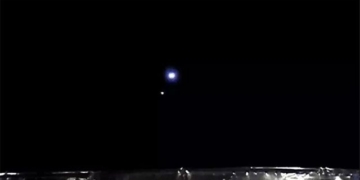From a Paradise for Seabirds, Gough Island Has Now Become a Hell with Nearly 2 Million Predatory Rats.
Gough Island is located in the South Atlantic Ocean, roughly between Africa and South America. It is part of the Tristan da Cunha archipelago, which belongs to the United Kingdom. The island is small, with a total area of only about 68 km2, named in honor of the British mariner Charles Gough, who passed by the island in 1731 and accurately described its coordinates.
Due to its small size and cold climate, only a few people work at the meteorological station on a rotating basis. However, long ago, some merchant ships stopped by the island, bringing along house rats that managed to escape and settle there.
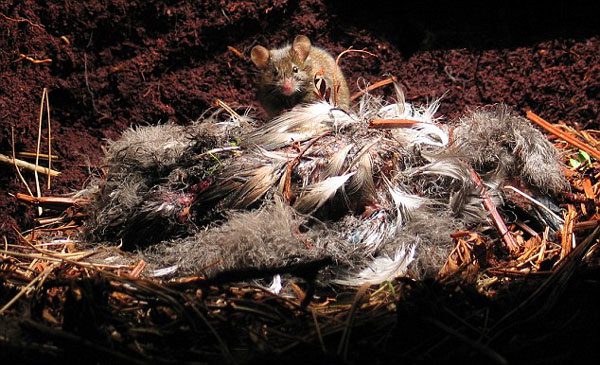
Fat and rapidly growing rats.
The common house rat found Gough Island to be an excellent habitat. With no predators to threaten them, the rats reproduce at an astonishing rate, and their size increases rapidly.
The average length of these new inhabitants reaches up to 27 cm (including the tail), while their relatives living in their “old home” (i.e., England) measure only 7 to 10 cm, with very few exceeding 11 cm. This means that the rats on the island are one and a half times larger than the biggest rats on the mainland.
One might think that only humans could devise bloody feasts, consuming the brains of living animals. However, on Gough Island, a remote island in the South Atlantic, this label of brutality is reserved for the “gangster” rats.
In several video trap placements, the Royal Society for the Protection of Birds (RSPB), a UK wildlife conservation organization, captured footage of a “gang” of rats attacking the nests of seabirds.
Their goal is to kill and eat the brains of the chicks. For larger, self-defending birds, the rats will jump onto their heads and bellies and gnaw at their flesh.
Each return visit for the rats is a wild feast as they continue to consume the unfinished portions of their meals. Meanwhile, the unfortunate seabirds remain alive but have no way to resist.
Gough Island is one of the most remote locations on Earth. It lies between the South Pacific Ocean, along the route connecting Cape of Good Hope in South Africa and Cape Horn in Chile – the southernmost point of South America.
This island was first discovered by Portuguese sailors in the 16th century. However, due to its remote geographical position, no one dared to inhabit it, and no country wanted to claim sovereignty over it. It wasn’t until 1938 that the British Royal Navy landed here and annexed Gough Island to Britain.
Before human presence, Gough Island was home and paradise for Tristan Albatrosses (Diomedea dabbenena) and Atlantic Petrels (Pterodroma incerta). Almost the entire population of these two bird species in the world resides there.
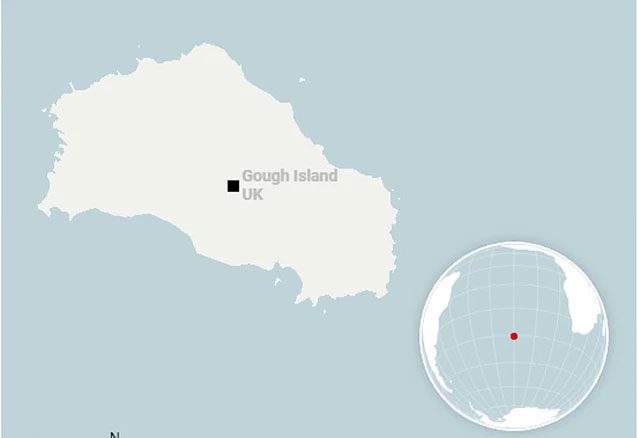
Location of Gough Island.
Scientists estimate that there are about 10 million individual birds on Gough Island belonging to 20 different species. Additionally, it is home to a population of fur seals and several species of whales from the South Atlantic.
Consequently, Gough has been recognized by UNESCO as a World Heritage Site due to being one of the least disturbed ecosystems on the planet. This was until sailors in the 19th century frequently visited and brought along an unwelcome guest, a dangerous invasive species: House Rats (Mus musculus).
There Are 2 Million Rats on the Island, Each One One and a Half Times Larger than Normal
We know that house rats are a wild species, but they have evolved and adapted to living conditions close to humans, where food and shelter are readily available. Living alongside humans also means that rats are protected from predators such as snakes or hawks.
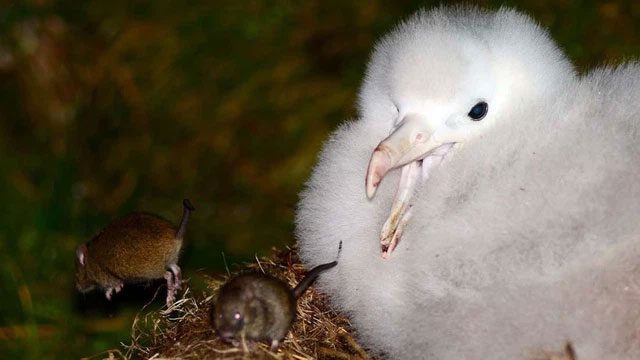
The goal of these rats is to kill and eat the brains of the chicks.
These rats then followed sailors onto ocean-going ships and were taken around the world. Especially during the European colonial period, with each new land and island they reached, house rats found a way to get there and stay.
Gough Island is truly just one of the victims of the rat epidemic. But this location is a typical victim and suffers the most severe impact.
Since the island is uninhabited, house rats have had to return to forage in the natural environment. And on Gough Island, there are readily available bird eggs and young seabirds that they can prey upon.
With no natural enemies on an island in the South Atlantic, house rats thrive. In the summer, their population density can reach up to 300 rats per hectare. This means that on Gough Island, which is 65 km2, there could be as many as 1.9 million rats in total.
And this is a nightmare for the seabirds nesting and laying eggs here.
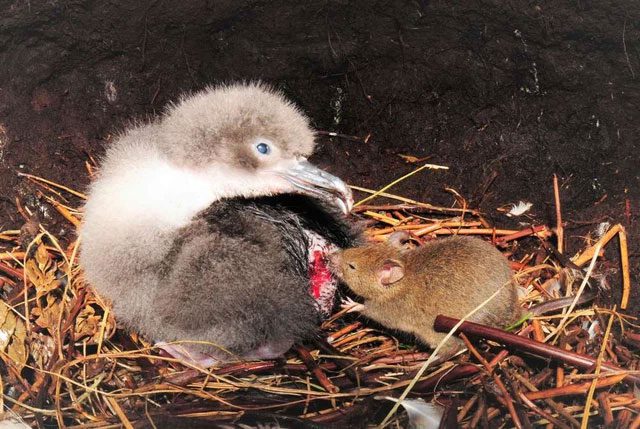
With no natural enemies, house rats thrive.
Bloodthirsty Satanic Rats Have Turned Paradise into Hell
Incidents of rats attacking seabirds have been recorded on Midway Atoll in the North Pacific. On Gough Island, after many years of appearing cute and only nibbling on plants, the rats have overpopulated, leading to a depletion of food sources and forcing them to turn to hunting young seabirds.
But it doesn’t stop there. In recent years, the Royal Society for the Protection of Birds has reported that house rats on Gough Island have begun attacking adult seabirds as well.
Birds standing up to 1 meter tall and weighing 300 times more than the rats are also being surrounded and gnawed at. During attacks on seabird nests, the rats often come in “gangs” of up to 10. They typically gnaw at the feathers and skin on the heads and bellies of the albatrosses before returning multiple times to eat into the brains and intestines of the unfortunate birds.
A gang of rats attacking seabirds on Gough Island
In 2004, Ross Wanless, a scientist at the University of Cape Town, South Africa, set up infrared cameras to monitor 300 Tristan albatross nests on Gough Island. The results showed that the rats attacked and killed 256 of those albatrosses.
Although the total population of 20 bird species on Gough Island is around 10 million, only about 2,000 Tristan albatrosses remain alive. Scientists are therefore concerned that house rats could accelerate the extinction of this species.
They estimate that the rats have killed adult birds and reduced more than 2 million bird eggs of various species on Gough Island. The survival rate of chicks has also decreased from 70% to just 27%.
Chris Jones, an assistant in the RSPB’s seabird conservation program, stated: “The attacks of rats on adult birds could devastate the population’s chances of survival, as each of these birds can lay dozens of eggs throughout their lifetime.“
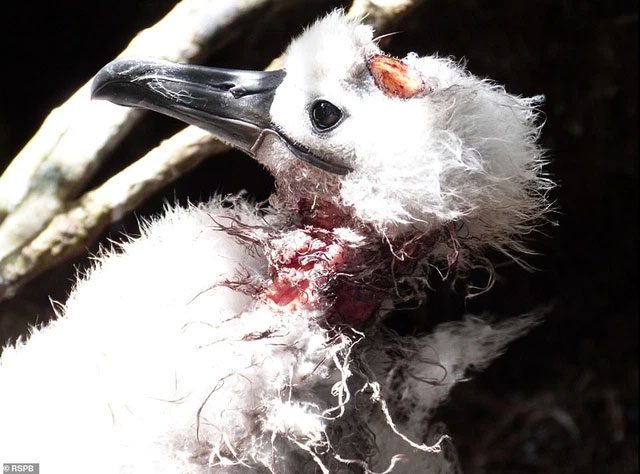
Rat attacks on adult birds could devastate the chances of survival for the bird population.
We know that albatrosses are monogamous and lay one egg every two years. Therefore, to protect these lives from the bloodthirsty rats, the RSPB has implemented a plan to eradicate all rats on Gough Island.
Last year, they used helicopters to drop baited grain containing rat poison onto the island. The program was funded up to £9.2 million, but by the end of 2021, it was assessed as a failure.
This is because scientists found that the rats had consumed the bait on Gough Island but were still alive. The island, therefore, remains a hell for seabirds as long as these bloodthirsty satanic rats are still there.





















































